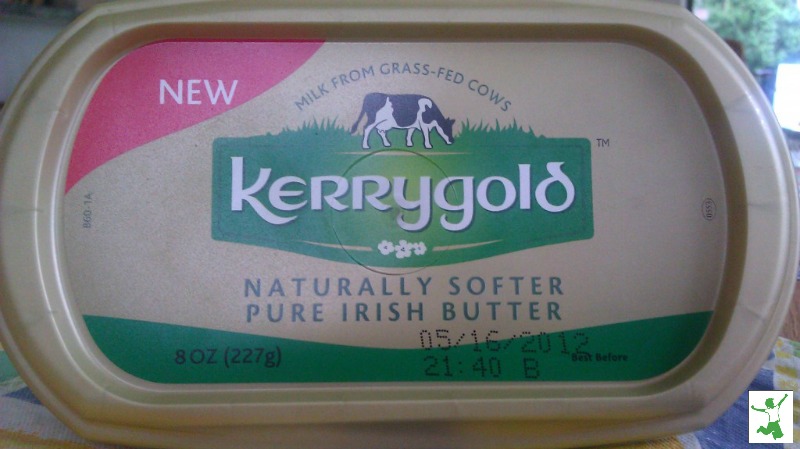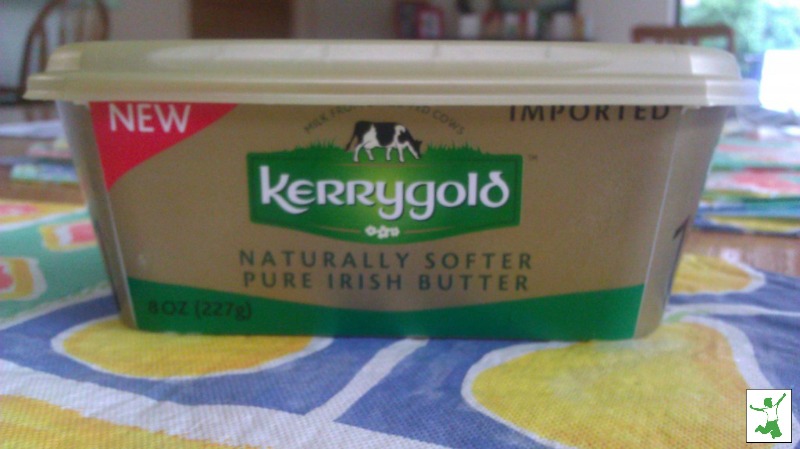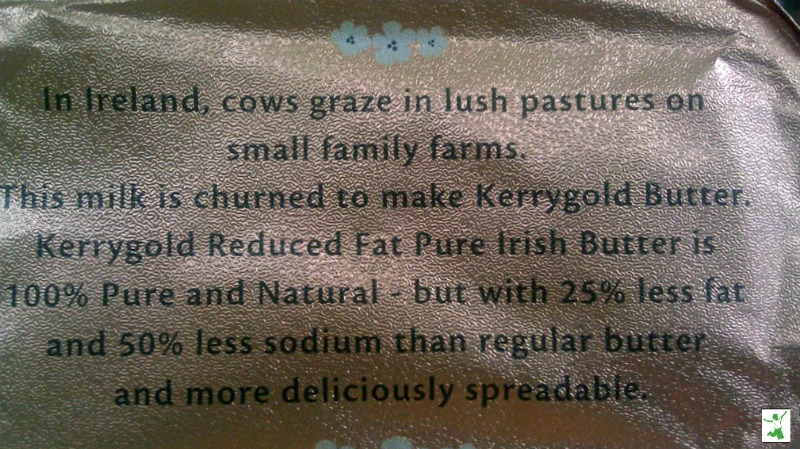Table of Contents[Hide][Show]
Kerrygold is marketed as grass-fed and all-natural, but the tub butter has concerning ingredients, dangers and marketing ploys to consider before buying.

Kerrygold, without question, is probably one of the best store butters you can buy. I myself have been using it for years for cooking.
The milk is from grass-fed cows and even though the cream used to make Kerrygold Butter is pasteurized, it is the best choice available to most folks who do not have access to raw butter from a small farm or who simply don’t want to use their precious raw butter for cooking.
I also know that many of you out there use Kerrygold too. When I conducted a Butter Poll on this blog awhile back, by far the most used butter (out of 1,500 or so total votes) was Kerrygold which received way more votes than even Organic Valley butter.
So what’s the problem?
My husband brought home the “new” Kerrygold butter the other day. On the surface, it looked fine. Nowhere on the outside of the package was there any indication that there was a problem with this butter. Here’s what it looks like.

I got suspicious with the “new” label, however. There’s nothing “new” about butter. That’s what I like about it after all!
Another tip-off that there was a problem lurking was the proclamation on the label that this “New Kerrygold” was “naturally softer”.
When I first saw the “naturally softer” words, I thought that meant that the butter was whipped and hence more spreadable. I don’t know about you, but I don’t want air whipped into my butter. This is a surefire way to get less product and get charged the same price for the privilege if you know what I mean.
I made a mental note to tell my husband not to buy this butter again because it was whipped and not as good a value.
But then, it got way worse…
Is Kerrygold Butter Grass-fed?
I took off the lid to the new Kerrygold package and saw the following words:

I had become a victim of the Big Fast One!
Kerrygold is stealthily selling LOWFAT butter and guess what? You get to pay the same price for the cheaper quality!
NOWHERE on the outside of the label did it say that the butter was low-fat. The ingredients said simply: pasteurized cream and salt the same as the commercialized Amish butter at the supermarket.
I daresay that this marketing ploy will be fooling a lot of folks who desire to buy full-fat grass-fed butter.
It seems that some butter brands have adopted what companies making substitutes for butter have been doing for years.
I have become very tuned in to these labeling tricks and manufacturer games over the years. When it comes to packaging, I double-check the ingredients along with the manufacturing processes every few months. This is even for products that I’ve been buying for years.
But how many people really do this?
Ingredient Bait and Switch
You NEED to be doing this!
Manufacturers are changing ingredients and packaging all the time! The primary intent of these “improvements” is to increase product sales and profitability. Your health is, sadly, of little to no concern in the grand scheme of things.
Reducing the fat content in its butter will skyrocket profits for Kerrygold as they will make the same per unit for the butter and yet be able to sell the skimmed cream to other companies to make ice cream or whatnot thereby increasing revenue substantially.
If you buy Kerrygold, I’m not telling you to stop buying it. I’m only telling you to beware of this new packaging nonsense and be sure what you buy is what you intend: full-fat butter!
By the way, if you are wondering why I love full-fat butter, you might want to educate yourself on the low-fat scam by learning about the history of butter vs margarine in the United States.
As for me, I will be returning this product to the store for a full refund. It is falsely advertised after all. I had no way of knowing it was a low-fat product until I opened it.
Manufacturer Response
I received this email from Kerrygold following the widespread sharing of this article. I find it very hard to believe that my blog suddenly brought this packaging error to their attention.
Do they have NO ONE on the production line in charge of quality control? This was not a difficult problem to identify. Could we have a bit of spin going on here? Perhaps so.
Dear Sarah,
Your blog has brought to our attention a packaging error of which we were unaware. While Kerrygold does sell a Reduced Fat & Sodium Butter the pack you show on your blog is 100% full fat butter which has been packed with the incorrect inner seal. There is no deliberate intent on our part to mislead our valued consumers or to misrepresent our product although we regret the confusion this is clearly creating.
We are working to identify how much product has been released into the market with the incorrect packaging so that we can replace it as soon as possible. In the meantime we would appreciate your assistance in clarifying the misunderstanding to your readers. We would love to provide further clarity — our email is [email protected] — and we are happy to answer any specific questions you and your readers may have in relation to the product.
With thanks & regards,
The Kerrygold Team
Why I No Longer Buy Kerrygold
I wanted to let all of you know that I no longer buy even the traditional Kerrygold brick butter in foil packaging. Why? A good friend visited Ireland and traveled extensively to a number of grass-based dairy farms.
This credible source told me that while the cows that provide cream for the Kerrygold butter are definitely on pasture and hence “grass-fed”, they receive supplemental GMO animal feed as well especially during the winter months. The local community and citizenry in Ireland concur and will tell you as much if you are in the area.
So, the word on the street is that Kerrygold is not legitimately pastured either.
Butter from cows that get GMO feed introduces the very real possibility of Roundup residue in the butter.
Thanks but no thanks!
While I have not been able to confirm this story 100%, I trusted the credibility of the information enough to permanently switch to another brand (I currently use this one).
I use this butter for cooking in addition to the homemade pastured raw butter I make for non-cooking purposes.
I also no longer recommend Kerry Gold in my Shopping Guide.
What about Organic Valley butter as an alternative to Kerry Gold? While I am not happy about Organic Valley’s policy that disallows member farmers to sell raw milk on the side to their community (treating them more like medieval serfs than the independent business owners that they are), I find this less onerous than deceptively feeding animals GMO feed without clearly informing the end consumer.









good point Rob, seems like Sarah is a good candidate for growing all of her own food because sometimes products miss the mark. I am all about transparency in businesses, if they can’t be upfront about their production methods then maybe they shouldn’t be trusted. I’ve actually heard rumors that some of the ‘small farms’ kerrygold sources from could be feeding GM corn as well.
My guess when I saw the new “reduced fat” spreadable butter was that they increased the milk solids (the stuff you get rid of when making ghee) so that it still has a lot of flavor but less fat, and stays soft. I noticed on the reduced fat stuff that the ingredients are not different and the weight is the same (8 oz), so they may be playing with the proportions of milk fat to milk solids in the product rather than whipping in air.
I buy both Kerrygold and Smjor butter regularly at Whole Foods. Smjor is a bit cheaper, but the unsalted butter is not cultured like Kerrygold is.
Beware the New KerryGold Butter – The Healthy Home Economist http://t.co/BjGoGujN
This is frustrating! Can’t trust any business anymore: "@HealthyHomeEcon: Beware the New KerryGold Butter ;
Sarah, Regarding… “By the way, how do you know what they say is even true? Companies lie all the time to protect profits.” Then i Guess it best we grow our own Fruit, Vegetables, raise are own animals etc. Can we even trust the USDA Organic symbol ???
thanks for the heads up!
Hi Sarah, do you not have a picture of the nutritional information that was posted on the side of the container ?? Just interested in knowing what it said…
Wow, Sarah, when I saw your headline in my email I thought, Uh oh, now what have they done? I love Kerrygold butter, which I had never heard of until I read it on cheeseslave.com. I just want to say thanks for being the watchdog I’m not. I try, but you are much more diligent. Now I have to go check the stonyfield yogurt I just bought. For what I’m paying it better not be messed up!
So shame on a company for trying to appeal to another market different from us? Unfortunately lots of people are still afraid of fat and kerrygold’s “lowfat” is still better than synthetic margarine. How do we know any company is telling the truth? We go based on their reputation and our willingness to trust them. How do we know tropical traditions processes coconut oil the way they say? Have we visited them? I haven’t, but I choose to trust them. And I still trust kerrygold; their decision to market a lower fat butter has nothing to do with me b/c I won’t buy it anyway. My issue w your post is that it reads like fact and it isn’t based on evidence, but on conclusion jumping. But it is your blog and your prerogative.
I find your argument sound. I find Sarah’s perspective interesting. You both have GREAT points! It’s all a very fine line.
It’s also better for kerrygold for me to blow the whistle on this if you want to play devil’s advocate and take the company’s side. If nothing had been said or posted, they would have quietly started losing customers without knowing why. Posting about it and bringing attention to the problem is always the way to go then they can fix the problem and move on.